After Trash: The Not-So-Brief and Wondrous Life of a Plastic Toy
BY CYNTHIA DENG AND ELIF EREZ
April 9, 2018
(INTRO)
Mexico City produces waste at a rate of 12,920 tons a day[1] – where does all of it go, and how? This deceptively simple question has no direct and simple answer. Behind the daily processing of waste is a vast urban network comprised of thousands of individuals, institutions, organizations, and infrastructure systems. Investigating this network calls to question the definition of “waste,” and the nature of usefulness, worth, and obsolescence in objects. Waste, as it turns out, is also highly symptomatic of a city’s social and political stratification, as well as its cultural value systems. If “you are what you eat” is true for people, then cities are what cities waste.
In Mexico City, the boundaries of responsibility, legality, and formality in the world of trash collection are highly blurred. The formal, government-led side of Mexico City’s waste infrastructure is heavily dependent on a network of pepenadores[2], machetes[3], basureros[4] and other informal workers whose livelihoods revolve around sorting, collecting, and selling waste. These individuals carry out their work in grey zones of legality, not on government payroll, but are often engaged in an exchange of labor or goods for government actors. Hence, informal workers are rendered invisible in public policies, as well as in government data and official maps on the waste collection network of Mexico City. The ensuing legal and financial precarity of these individuals compound the health and safety risks, vulnerabilities to exploitation, and stigmas associated with waste workers. As Mexico is a signatory to the Universal Declaration of Human Rights, it must recognize work under just and favorable conditions as a fundamental human right.[5] As such, the current invisibility of informal waste workers constitutes the violation of many of their human rights.
We believe that the reconstitution of these human rights begins by making visible the work and true narratives of these individuals. The scope of this article allows us to cover only a very small piece of an enormous, multi-layered network, but nevertheless, we hope that it will help illuminate the complexity of the lives of objects and people “After Trash”. We will follow the journey of an object, a plastic toy figure after it has been discarded. Along the journey, we will meet various workers who will handle, exchange, and ultimately add value to the discarded object. Each character described in this story is real, and the information and photos depicted come from personal interviews our team has conducted in Mexico City during the summer of 2017, as part of the Mexican Cities Initiative Fellowship.
We are among a group of Harvard Graduate School of Design students who were recipients of the Mexican Cities Initiative Fellowship to investigate waste networks in Mexico City. During our fellowship period in the summer of 2017, we interviewed and shadowed many individuals across the spectrum of formality, ranging from government officials to scavengers, and began to trace their daily trajectories through the city, tracking networks formed through the exchange of waste materials.
(Chapter 1 – Luisito)
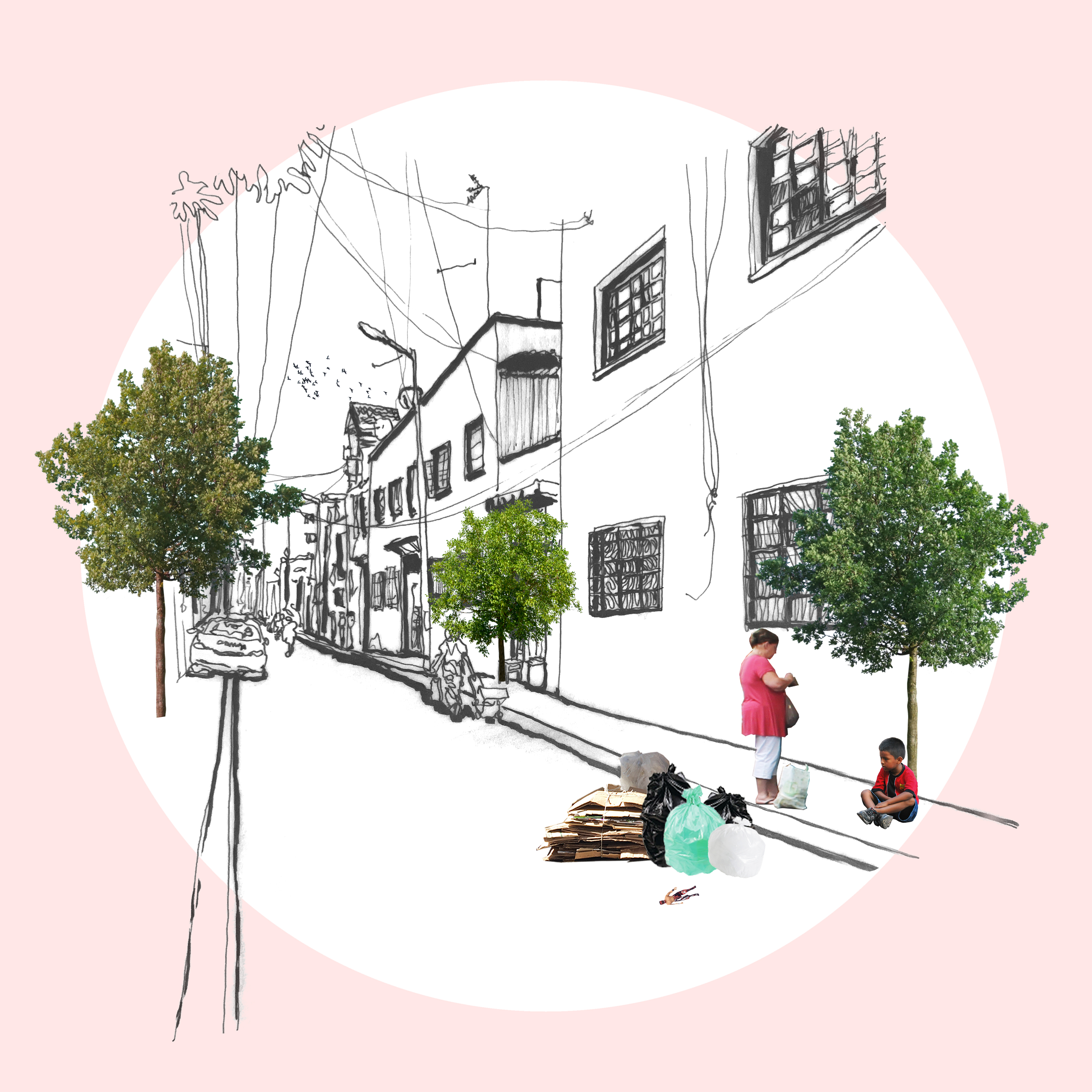
Through tears, Luisito watches as his mother picks up the severed arm of his old Lucha Libre action figure[6] and throws the arm and body into the trash piled out in front of their building in Colonia Obrera. “It’s broken. That’s what will happen if you keep throwing your toys out of the window! Señor Luchador may be strong, but he is plastic after all.” She wrinkles her nose at the smell wafting off the streetside trash-pile, but she knows that in an hour or so the trash truck will come clear up that mess. “If we had put a shrine to Virgin Mary on the façade[7] like I suggested at the neighborhood committee meeting, people would not be throwing trash in front of our building,” she thinks as she turns to face Luisito.
(Chapter 2 – Espirillón)
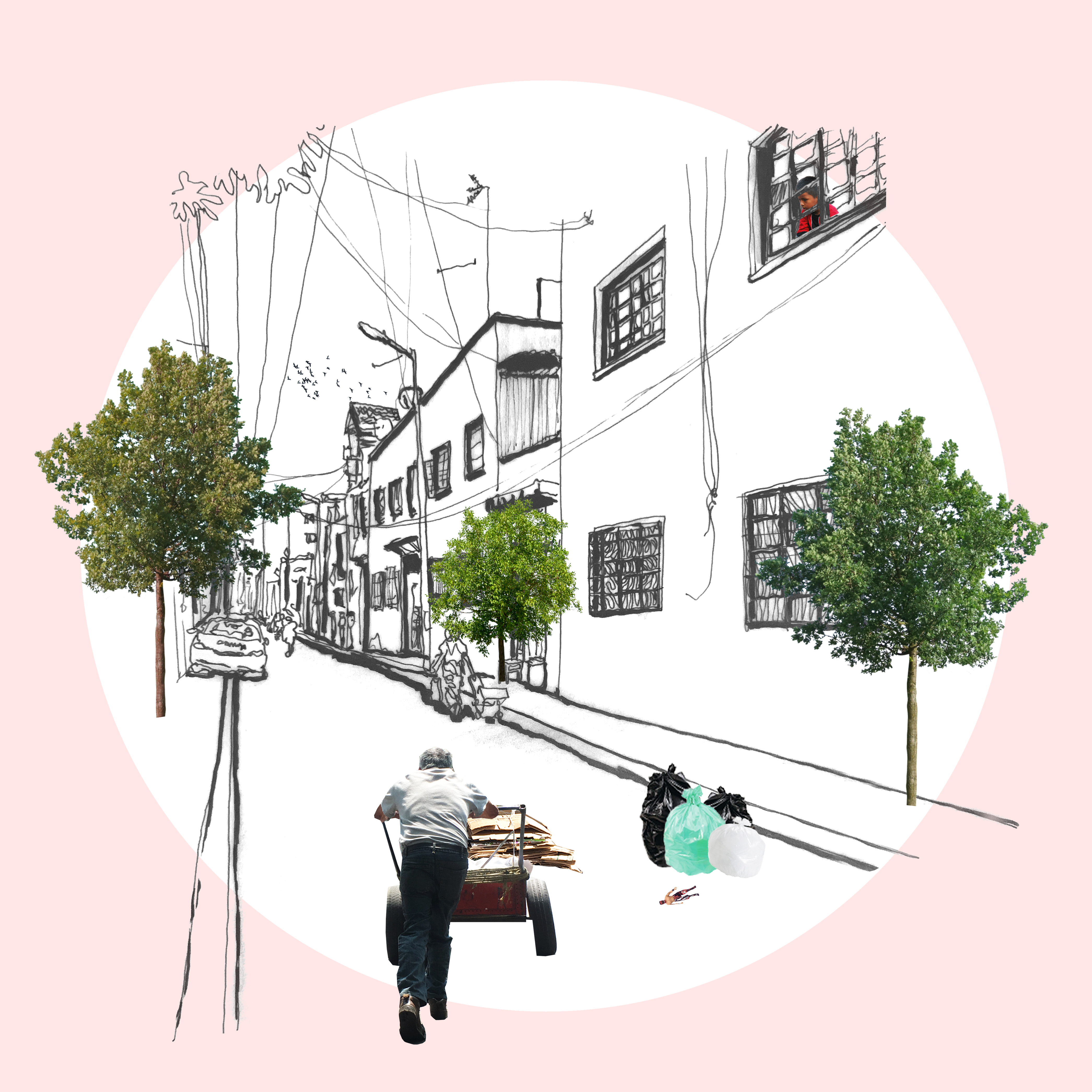
Espirillón scavenging for trash.[/caption]Passing by on his daily scavenging route, Espirillón spots the action figure and a few pieces of cardboard in the trash pile. After a series of quick mental calculations, he grabs the cardboard out of the pile and folds it neatly into his cart, but he leaves the action figure behind. Cardboard is going for a good price today, and the action figure is not worth the space it would take up in his cart. He needs to earn enough today so that he can buy food and still pay back the rent for the cart.
He can hear loud crying from a nearby window, something about “wanting Señor Luchador back.” Espirillón thinks to himself, kids are getting so spoiled these days. Orphaned at the age of two, he grew up on the streets himself. He never knew his parents and was not even sure if his name was really Espirillón, but that was what everyone called him. Espirillón never went to school but prided himself on having learned to read by following newspaper-readers around and asking them to read aloud articles for him. He is 75 years old now and has spent the last 15 years renting this cart to scavenge for and sell valuable materials from trash. Before that, he had spent 17 years in prison, the saddest years of his life he tells anyone who will listen. And before that, he was a truck driver for the beer company, Modelo. He is happy with his situation now, living in the back of a truck in his friend’s parking lot. Not where he pictured himself at this age, but he has honorable work and is feeling especially satisfied with himself after finding a nice stack of clean cardboard to sell.
(Chapter 3 – Guillermo, Ilario, Ricardo and Javier)

Guillermo hits the brakes after pulling Truck 603 into the street, just in front of the streetside trash pile. Longtime colleagues and unpaid trash workers Ilario, Ricardo, and Javier jump off the back of the truck and begin shoveling the contents of the trash pile onto the back of the truck. They make sure to pick out the plastic, glass, and metal to sell later. A barrandero, an official uniformed street sweeper employed by the sub-municipal government of Delegación Cuauhtémoc, passes by with his cart, nods hello to the workers, and continues along his pre-determined route to knock on apartment doors and collect household waste.
The government calls informal workers like Ilario, Ricardo, and Javier “volunteers,” as if they voluntarily do this unpaid work out of the goodness of their heart while in truth it is their livelihood. “Volunteers” make their living by selling the recyclables and other valuables that they sort from the trash every day and from odd tips they collect from citizens who give them trash directly. Whenever somebody doesn’t tip them, Ilario likes to joke that the guy would be swimming in his own trash if they stopped showing up at his doorstep every morning. Ilario has been working (or “volunteering”) on this truck for over thirty years. He likes the autonomy – way better than a desk job. Ricardo dropped out of university to work since his family needed the income, but he thinks he will go back one day. His uncle was a street sweeper and had set Ricardo up with this gig. Javier used to be a metalworker and still does welding jobs on the side, but he cannot support himself welding full-time. Guillermo is among the lucky few thousand who drive trash trucks on government payroll. His dad was a trash truck driver, too. None of them lives in this neighborhood, and their daily commute is anywhere from an hour to almost two hours long.
The trash pile is big and takes a good ten minutes to finish up. While sorting through it, Ilario spots the bright mask of the action figure and pulls the figure out just before the compressor crushes it. He puts the action figure into the crate above the back opening of the truck, where they store tchotchkes and interesting trinkets they find in the trash. He knows exactly where he can sell them for some extra pesos.
(Chapter 4 – Arturo)
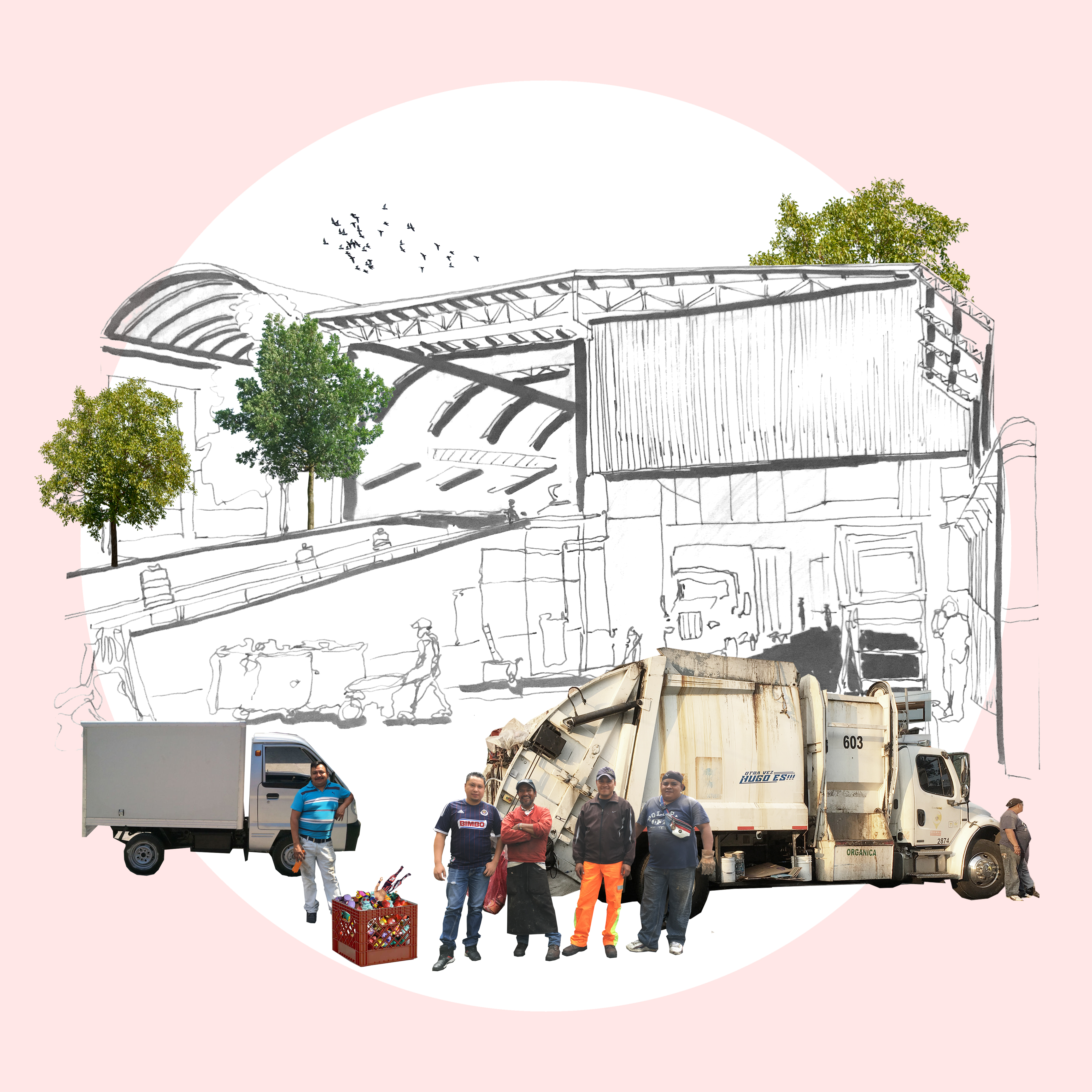
Selling of tchotchkes in front of the transfer station.[/caption]After making a few more stops on its daily rounds, Truck 603 is filled up and needs to empty its load of trash at the transfer station. Before pulling onto the special truck platform for the separate dumping of organics and inorganics, Guillermo pulls over just outside the transfer station, in front of a small cargo truck parked to the side. Their friend and nomadic vendor, Arturo, is often stationed at this spot, where he can buy tchotchkes and small valuables from trash trucks right before they enter the transfer station. After a quick round of bargaining, Ilario and the others agree to sell their crate of tchotchkes to Arturo, who empties the contents of the crate, including the action figure, into a larger plastic tarp bag full of used toys and random found objects.
Arturo typically buys tchotchkes, clothes, and some metals from his contacts, from about 15 of the trash trucks who come to this transfer station. He comes here on Tuesdays and Thursdays, and on other days he buys from outside another transfer station. He lives over on the eastern side of the city but comes here to do business because he knows the best-scavenged material comes from these districts, where well-to-do folks throw out perfectly fine things because they cannot bother to repair and reuse them.
(Chapter 5 – Mónica)
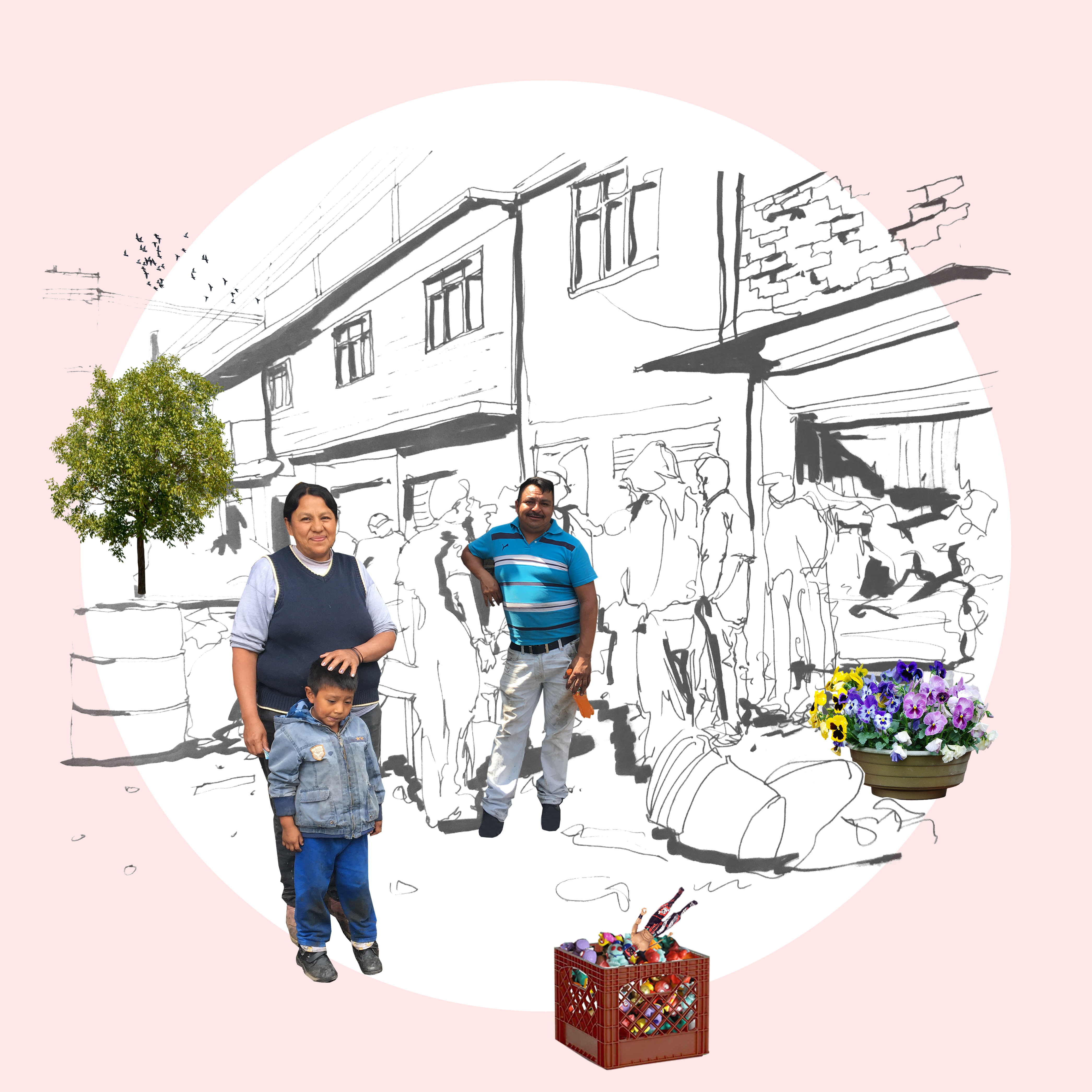
At the end of the day, Arturo drives to the recollection center in Iztapalapa owned by his friend Mónica. He hauls the bag of tchotchkes in to set it onto the scale, and after inspecting the final weight, Mónica pays him. After chatting for a bit, Arturo sets off for home.
Mónica acquired this plot of land underneath the highway from her father. Before she repurposed it as a waste recollection center, her father had used it as a junkyard for vehicles and as a mechanical repair center. Since childhood, she had worked in the mechanical workshop with her brothers and her father. When she was younger, she and her friends would go up to the Santa Caterina landfill to collect plastic bottle caps and sell them for extra pocket money. Her classmates would taunt her for working at the landfill, but she brushed it off because the trash made her money. Mónica also knew the days when the best baking company in the neighborhood threw out their cast-off pastries—those were the best days of the month. Throughout all this, she transitioned to working mainly in trash recollection as she became an expert on gauging potential resell values, predicting market prices for reusables, and growing a wide network of colleagues and acquaintances who would trade with her. She has been operating this brick-and-mortar recollection center for about five years, though she had been a nomadic collector like Arturo for quite a while.
(Chapter 6 – José)
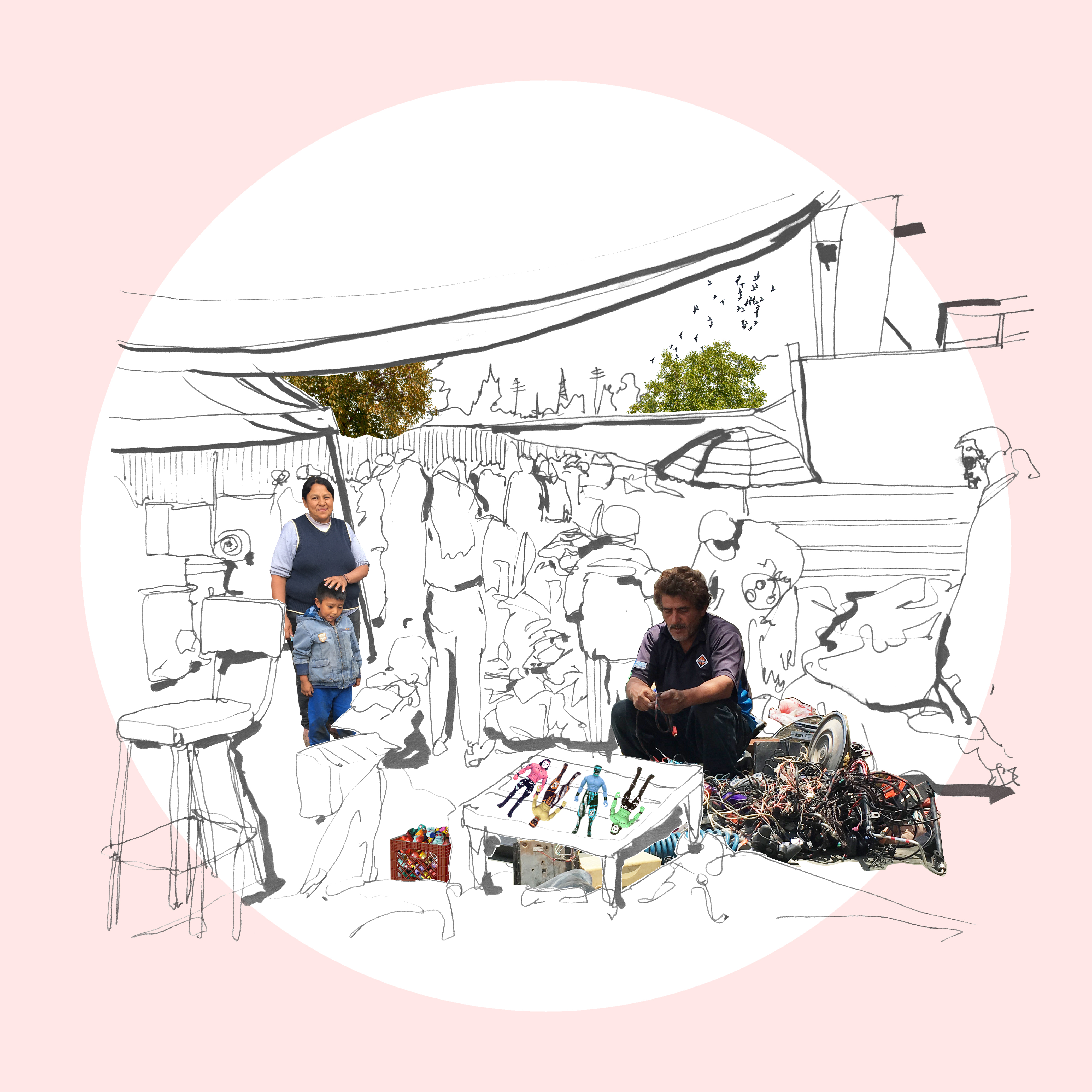
The night before the Wednesday tianguis[8] of Santa Marta Cárcel, Mónica and her colleague José truck in their load of tchotchkes to the area where they will set up their stall. At 5:00 am José starts setting up shop, spreading his tarps out on the street and arraying the objects in neat little rows. He spends the last hour before buyers arrive repairing some of the broken tchotchkes. He even finds a new arm for Señor Luchador. Fixed and looking as invincible as the day Luisito had pulled him out of its new plastic box seven months ago, Señor Luchador lies in a row with three other action figures that Mónica had collected over the week from various vendors.
José is generally wary and keeps a cautious eye out for trouble, even as he gets busy exchanging cash with buyers. Last week, due to a scuffle between tianguis vendors, the policemen had come by and tried to clear the street off. That was disastrous for the business and forced them to go into debt for the week, so he really needs to recover the lost profits today. This was a precarious source of income but he has a family to feed, so every Wednesday for the last 20 years, he has come to sell tchotchkes for Mónica.
(Chapter 7 – Antonio)

Antonio, from the Harvard Graduate School of Design Tracking Trash research team, is roaming the tianguis looking for individuals he might be able to interview – he is mainly interested in their daily lives and routines, how often they come to the tianguis, and where they get their objects from. As he is walking by Jose’s tarp, his eye catches the newly fixed Lucha Libre action figure. He suddenly remembers his nephew’s plea “Toni, please get me one of those masked wrestler figures, I think they call them Luchadores!” How could he forget? This was the one thing his 5-year-old nephew had requested he brings back to Puerto Rico after his research trip to Mexico City. Luckily, José agrees both to be interviewed by the Tracking Trash Team and to sell Antonio the action figure. As such, Señor Luchador becomes reincarnated in another use cycle in its Life After Trash, generating value and income for multiple actors in this complex network of material flows.
(OUTRO)
After an object is thrown out as trash, it passes through many hands, and its monetary value and use value fluctuates drastically. The individuals involved in this network of objects “after waste” not only divert discarded material from landfills but also turn the notion of waste on its head. Waste becomes a resource, a generator of value, and an economic commodity that provides for the livelihoods of many. Informal workers provide an essential service to Mexico City in terms of processing the daily 12,920 tons of trash generated by its citizens. Yet, they are not recognized or fairly compensated, to the detriment of both the workers’ and the city’s health and wellbeing.
A recent letter published by the global action-research-policy network Women in Informal Employment: Globalizing and Organizing (WIEGO) determined that the Mexico City government is “benefitting from (the) services (of informal trash workers) while disregarding its obligation to guarantee their protection, respect and guarantee of their human rights: specifically, to ensure as a bare minimum the right to work, the right to access waste, and non-discrimination and protection of employment equality.”[9] The recognition and compensation of these workers require an approach that is equal parts top-down and bottom-up. On the one hand, policy-makers and administrators have to acknowledge and accommodate informal workers in their decisions, providing the guarantee of safe and sanitary working conditions; legal and financial recognition and therefore visibility; social security measures; and the possibility for self-employment or for creating cooperatives[10].
At the same time, organized worker collectives and citizen advocates can generate bottom-up momentum. Precedents of fair remuneration and protection of informal waste workers exist in other Latin American cities. Waste pickers in some Brazilian cities (such as Belo Horizonte, Itaúna, Aranxá, Sao Paulo) have formed cooperatives that successfully fought for formal recognition and are now paid by the municipality for their services. Since 2013, Bogotá, Colombia has replaced contracts with private waste collection companies (with direct payments to waste pickers), which doubled the pickers’ income while reducing overall municipal waste management costs.[11] These and other examples prove that it is possible to create a framework that protects the human rights of informal waste workers.
We believe that our role as third-party researchers is to come up with a scenario that can best introduce the role of design and interdisciplinary thinking as an integral part of the solution. The best approach, in our opinion, is one that begins with a narrative: telling the diverse stories of the social, economic and political relationships woven through the network of trash workers. As such “Tracking Trash” is about so much more than merely “tracking,” or merely “trash” – it is about the complex, multi-layered stories that revolve around the life of materials after trash, lives that are definitely not brief and definitely quite wondrous.
References
[1] Ciudad De México, and Cristal Berenice Ayala Hernández et al. Inventario De Residuos Sólidos. Publication. Mexico: n.p., 2016. La Secretaría Del Medio Ambiente Del Gobierno Del Distrito Federal. Web. <http://www.cms.sedema.cdmx.gob.mx/comunicacion/nota/publica-sedema-inventario-de-residuos-solidos-de-la-cdmx-2016>.
[2] Waste pickers or scavengers.
[3] Workers who sort and break down trash on trash trucks.
[4] The person who comes to your front door and picks up your trash.
[5] Article 23: “Everyone has the right to work, to free choice of employment, to just and favourable conditions of work and to protection against unemployment, 2. Everyone, without any discrimination, has the right to equal pay for equal work, 3. Everyone who works has the right to just and favourable remuneration ensuring for himself and his family an existence worthy of human dignity, and supplemented, if necessary, by other means of social protection, 4. Everyone has the right to form and to join trade unions for the protection of his interests.” United Nations Human Rights Office of the High Commissioner. Universal Declaration of Human Rights. pub 08.13.1948. Accessed 4.8.2018. http://www.ohchr.org/EN/UDHR/Documents/UDHR_Translations/eng.pdf
[6] A popular Mexican toy of a masked wrestler.
[7] It is a common practice in Mexico City to install a streetside shrine to Virgin Mary directly on the façade of a building – besides its religious value, the shrine also helps discourage citizens from dumping trash anywhere near the edifice.
[8] Tianguis are informal street markets that take place on certain days of the week when entire stretches of streets are closed off to traffic and covered in tents, impromptu stalls and tarps laid on the ground.
[9] Women in Informal Employment: Globalizing and Organizing (WIEGO). Martha Alter Chen, International Coordinator, WIEGO et al. Letter of Recommendation to Authorities. 07.2016. Accessed 08.04.2018. http://www.wiego.org/sites/default/files/resources/files/Letter_CDHDF_Recommendation.pdf
[10] Suggestions taken from the Letter of Recommendation to Authorities, ibid.
[11] Ibid.
